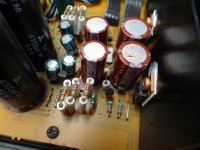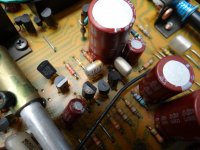in the 80's and maybe 90's manufacturers used a glue mostly around caps that dried and became toxic to PCBs and other components.
as I try to rebuild some equipment I am researching what is the best way to remove that old crud
in the searching for an answer that I have done so far, I found info on how horrible that stuff is and peoples thoughts on how you COULD remove it from people who have never tried. I found one thread that the OP asked this question and he tried their suggestions and none worked. a working answer never got posted in that thread.
I am hoping to hear from people that have an excellent method that has worked for them.
I have taken some sample pics for people who have not seen it. if you look real carefully you can see some components that have been attacked by the corrosive glue.
as I try to rebuild some equipment I am researching what is the best way to remove that old crud
in the searching for an answer that I have done so far, I found info on how horrible that stuff is and peoples thoughts on how you COULD remove it from people who have never tried. I found one thread that the OP asked this question and he tried their suggestions and none worked. a working answer never got posted in that thread.
I am hoping to hear from people that have an excellent method that has worked for them.
I have taken some sample pics for people who have not seen it. if you look real carefully you can see some components that have been attacked by the corrosive glue.
Attachments
Mechanical removal is the only safe way.
It's also way faster than any chemical.
Unless you want to try sulphuric acid. <-- JOKE, Do NOT try this.
It's also way faster than any chemical.
Unless you want to try sulphuric acid. <-- JOKE, Do NOT try this.
what form of mechanical removal?
a sharp pointed object ?
a small flat head screwdriver as a chisel.
I have tried mechanical in the past and it didn't seem to do a complete or clean looking job
do you have a better suggestion that what I have tried?
a sharp pointed object ?
a small flat head screwdriver as a chisel.
I have tried mechanical in the past and it didn't seem to do a complete or clean looking job
do you have a better suggestion that what I have tried?
I used to nickname it "Mitac gunge" after working for a company that used to repair computer screens when they were still worth it.
The only fix we had was to replace or clean by scraping any components that had been poisoned by it.
It rarely seeps beyond the plastic sheath on large electrolytic capacitors.
Resistors are cheap enough that they can be replaced as are most small transistors if they are not commonly faked types.
It makes most if not all component leads crumble right the way into the component itself.
I have in the past scrapped boards due to too many components being poisoned by it.
The only fix we had was to replace or clean by scraping any components that had been poisoned by it.
It rarely seeps beyond the plastic sheath on large electrolytic capacitors.
Resistors are cheap enough that they can be replaced as are most small transistors if they are not commonly faked types.
It makes most if not all component leads crumble right the way into the component itself.
I have in the past scrapped boards due to too many components being poisoned by it.
It is a contact-glue, basically a form of rubber dissolved in an organic solvent.
In principle, it could be dissolved/softened by a similar organic solvent, but there are two problems: the original solvent is now probably outlawed in most of the countries, for health/safety reasons, and the rubber undergoes an additional process of polymerisation/cross-linking with time.
This puts it in another, more difficult category.
It could probably still be softened with paint-stripper (dichloromethane) or acetone, but they will do more damage elsewhere than anything mechanical.
In addition, the sulphur used for vulcanization is released during the aging process, which is why the degraded glue becomes corrosive (and a bit conducting)
In principle, it could be dissolved/softened by a similar organic solvent, but there are two problems: the original solvent is now probably outlawed in most of the countries, for health/safety reasons, and the rubber undergoes an additional process of polymerisation/cross-linking with time.
This puts it in another, more difficult category.
It could probably still be softened with paint-stripper (dichloromethane) or acetone, but they will do more damage elsewhere than anything mechanical.
In addition, the sulphur used for vulcanization is released during the aging process, which is why the degraded glue becomes corrosive (and a bit conducting)
what form of mechanical removal?
a sharp pointed object ?
a small flat head screwdriver as a chisel.
I have tried mechanical in the past and it didn't seem to do a complete or clean looking job
do you have a better suggestion that what I have tried?
A flat style of scraper.
Be it a sharpened flat blade screw driver or something like a hobby knife with a chisel type blade.
Remove all components in the area so you can get as flat to the board as possible.
You want to try and push and crack the glue off and put as little force directly down on the board.
I then use a bit of flux remover with cotton buds.
If your super careful (and lucky), sometimes you can achieve a clean unmarked board.
Most times you can't.
Sometimes the glue will have damaged or discoloured the board.
I've also had to chase out the component holes where the glue has gone into those.
And repair affected top side tracks that go under components.
The exact process and result will change with every job as every one will be different in how brittle the glue is or isnt.
How hot it's been, the type of board, etc etc etc.
This is all about removing the offending glue for a good long term repair, not turning a pig into a show queen. 🙂
- Home
- Design & Build
- Construction Tips
- removing that toxic glue from PCBs

